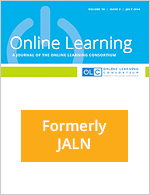The Road to Retention: A Closer Look at Institutions that Achieve High Course Completion Rates
From 2003 to 2007, enrollment in online courses nearly doubled, from 1.98 million to 3.94 million. By 2007, the 12.9% growth rate of online enrollments far exceeded the 1.2% growth of the overall higher education student population. Online education will continue to grow as a significant percentage of the 19...

